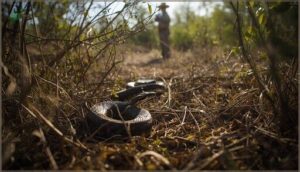This site is supported by our readers. We may earn a commission, at no cost to you, if you purchase through links.

A homeowner in California discovered a rattlesnake coiled near his porch and, without hesitation, killed it with a shovel. Days later, he received a notice of violation carrying a $5,000 fine. The legality of killing rattlesnakes isn’t as straightforward as many people assume—it hinges on your location, the species involved, and the circumstances of the encounter.
Federal protections under the Endangered Species Act shield certain rattlesnake populations, while state laws vary dramatically from unrestricted killing in Texas to strict prohibitions in New York and Pennsylvania.
Understanding these regulations isn’t just about avoiding penalties; it’s about recognizing rattlesnakes’ role in controlling rodent populations and maintaining ecosystem balance. Knowing when you can legally act, when you must call professionals, and what exceptions apply to immediate threats can protect both you and these often-misunderstood reptiles.
Table Of Contents
- Key Takeaways
- Is It Illegal to Kill Rattlesnakes?
- State Laws on Killing Rattlesnakes
- Rattlesnake Species Protected by Law
- Legal Penalties for Killing Rattlesnakes
- When is It Legal to Kill a Rattlesnake?
- Ecological Importance of Rattlesnakes
- Alternatives to Killing Rattlesnakes
- Common Misconceptions About Rattlesnakes
- Safe Practices During Rattlesnake Encounters
- Reporting and Compliance With Rattlesnake Laws
- Frequently Asked Questions (FAQs)
- Should you kill a rattlesnake in your yard?
- In what state is it illegal to kill a snake?
- What rattlesnakes are protected?
- Can I legally kill a rattlesnake in California?
- Are rattlesnakes protected in FL?
- In what states are rattlesnakes protected?
- Are you allowed to kill rattlesnakes in Arizona?
- What rattlesnake can you not kill?
- Are rattlesnakes protected federally?
- Why is it illegal to kill a rattlesnake in Texas?
- Conclusion
Key Takeaways
- Rattlesnake killing legality varies dramatically by state—Texas allows it for most species while California, New York, and Pennsylvania impose strict prohibitions with fines up to $5,000, and federal Endangered Species Act protections apply to specific populations like Eastern Massasaugas regardless of state lines.
- You can legally kill a rattlesnake only when facing an immediate threat to human safety, though most states require documented evidence of genuine danger and exhaust non-lethal options first, with property protection exceptions demanding permits after threat assessments.
- Rattlesnakes provide critical ecosystem services by controlling rodent populations that spread disease and damage crops, and removing them triggers cascading ecological disruptions including population explosions of pest species and destabilized food chains.
- Professional wildlife removal services achieve 68% success rates in safe rattlesnake relocation, and simple prevention strategies like clearing debris and installing snake-proof fencing reduce encounters by 40-80% without legal risk or ecological harm.
Is It Illegal to Kill Rattlesnakes?
You might think you’re free to kill any snake on your property, but rattlesnake protection laws say otherwise. Whether it’s illegal to kill rattlesnakes depends entirely on your state’s wildlife management regulations and the specific species you encounter. Multiple states prohibit killing rattlesnakes without permits or in protected areas, with penalties ranging from fines to misdemeanor charges. Federal protections under the Endangered Species Act can apply to certain rattlesnake species, limiting lethal control across state lines. Some jurisdictions authorize killing only under explicit safety threats, often requiring licensed professionals for removal.
Snake protection regulations recognize rattlesnakes’ role in ecosystem balance, venom research, and snake habitat preservation. Before you act, you’ll need to understand your local rattlesnake conservation laws—because what’s legal in one state could land you in legal trouble elsewhere. Students can prepare for AP Biology exams to learn more about species conservation.
State Laws on Killing Rattlesnakes
Rattlesnake laws aren’t one-size-fits-all across the United States. Each state has its own approach to protecting or permitting the killing of these reptiles, and what’s legal in Texas might land you with a hefty fine in New York.
Understanding your state’s specific regulations is essential before you take any action involving a rattlesnake.
Texas Rattlesnake Regulations
Texas grants you more flexibility than most states regarding venomous species. You can legally kill rattlesnakes without a permit in many situations, since they’re classified as non-game animals. However, wildlife conservation laws still apply—the Timber rattlesnake holds endangered status, triggering strict rattlesnake protection laws.
Local wildlife law enforcement may impose additional snake protection regulations, so rattlesnake relocation often acts as your safest bet for maintaining ecological balance.
California Rattlesnake Laws
California regulations impose strict wildlife protection on you—intentionally killing rattlesnakes without lawful authority violates the Fish and Game Code, carrying civil penalties up to $5,000 per animal. You’ll face steeper fines and potential criminal charges if you harm protected species like the red diamond rattlesnake.
Permit requirements from the California Department of Fish and Wildlife govern venomous snakes handling:
- Relocation permits require demonstrated competency in safe capture procedures
- County jurisdictions may demand additional local authorizations beyond state licenses
- Violations trigger misdemeanor charges, with animal cruelty statutes applying to intentional killings
Understanding the main topic details is vital for complying with these regulations.
Wildlife law enforcement coordinates with federal authorities when rattlesnake conservation crosses state lines, ensuring species preservation through compliance monitoring.
New York and Pennsylvania Protections
New York and Pennsylvania enforce some of the nation’s toughest snake protection laws—especially for timber rattlesnakes. You can’t kill, capture, or relocate these venomous snakes without a permit from wildlife authorities. Legal penalties include fines reaching several thousand dollars and misdemeanor charges.
Both states list timber rattlesnakes on their endangered species list, reflecting serious wildlife conservation efforts. Protective measures require you to contact licensed professionals for safe snake relocation.
Laws in Florida, Georgia, Colorado, and Idaho
Several states enforce distinct rattlesnake safeguards through regional enforcement mechanisms. Florida regulations protect timber and eastern diamondback rattlesnakes in specific counties, requiring permits for relocation. Georgia protections allow killing only when snakes pose immediate threats, with misdemeanor penalties otherwise.
Colorado safeguards certain species under wildlife conservation frameworks, while Idaho provisions limit harm outside licensed activities.
Each state balances venomous snake management with wildlife law and regulation through customized snake protection laws by state.
State-by-State Legal Differences
Regional variations in snake protection laws by state create a complex legislative framework that depends on species protection status and jurisdictional boundaries. Arizona wildlife laws and regulations differ from other enforcement mechanisms—Texas permits rattlesnake killing as non-game animals, while California restricts snake killing through tighter controls.
You’ll face different fines and penalties based on where encounters occur and whether threatened populations exist.
Rattlesnake Species Protected by Law
Not all rattlesnakes have the same legal standing. Some species enjoy strict protections under federal and state law, making it illegal to harm them regardless of the circumstances.
Understanding which rattlesnakes are protected can help you avoid serious legal consequences and contribute to conservation efforts.
Endangered and Threatened Rattlesnake Species
You might be surprised to learn that some rattlesnakes are protected species under state and federal law. The Eastern massasauga rattlesnake, for instance, holds threatened status under the ESA, while the Santa Catalina Island rattlesnake faces endangered classification in California. When you encounter these protected species, habitat preservation and wildlife management take priority:
- Several western rattlesnake populations carry threatened or endangered designations due to habitat loss
- IUCN Red List assessments rank multiple rattlesnake species from Near Threatened to Endangered globally
- State inventories list certain populations as “special concern,” restricting collection without permits
Rattlesnake research continues updating these protections as survey data reveal shifting population trends. Species conservation efforts focus on maintaining ecological balance through habitat restoration and public education about federally protected taxa.
Federal Endangered Species Act Protections
The Endangered Species Act acts as your legal guardrail when dealing with listed rattlesnakes. ESA enforcement prohibits taking, possessing, or transporting federally protected species without federal permits.
Habitat protection measures on federal lands restrict activities that could harm these species. Violations carry civil penalties and potential criminal charges, especially for intentional harm.
Conservation efforts under recovery plans aim to restore populations through habitat restoration and monitoring.
State-Specific Protected Species
Beyond federal listings, you’ll encounter state laws that zero in on specific rattlesnake species. Texas places the Timber rattlesnake on its endangered species list, while California extends habitat protection to the red diamond rattlesnake. Arizona’s wildlife conservation laws shield both the Arizona ridge-nosed and twin-spotted rattlesnakes.
The Eastern Massasauga earns protected species status across multiple state endangered lists, requiring permits before any interaction.
Legal Penalties for Killing Rattlesnakes
Breaking rattlesnake protection laws can cost you more than you might expect. The penalties you’ll face depend on whether the snake was protected, where you live, and whether prosecutors view your actions as animal cruelty.
Let’s look at what’s actually at stake if you kill a rattlesnake illegally.
Fines and Misdemeanor Charges
You’ll face real financial consequences if you kill a rattlesnake unlawfully. In Texas, wildlife fines range from $25 to $1,000 per incident, while California imposes misdemeanor charges with penalties between $500 and $5,000, plus potential jail time.
Federal Endangered Species Act violations carry steeper judicial consequences—up to $25,000 in fines and possible imprisonment, regardless of state hunting regulations or animal welfare policies.
Animal Cruelty Laws and Felony Risks
Beyond standard wildlife fines, animal cruelty laws escalate your legal consequences when you intentionally kill a rattlesnake in a cruel or inhumane manner. Arizona law and similar statutes classify unnecessary snake killing as animal cruelty, triggering misdemeanor or felony charges depending on intent and method.
Legal consequences under animal welfare laws include:
- Misdemeanor charges for first-time animal cruelty violations
- Felony charges for repeat offenses or egregious cruelty
- Enhanced penalties when protected species are involved
- Permanent criminal record affecting employment and rights
- Mandatory community service or wildlife education requirements
Penalties for Killing Protected Species
When you kill federally protected rattlesnakes, you’re looking at fines up to $25,000 under the Endangered Species Act—far steeper than state penalties for unprotected species.
Roughly 15% of state wildlife agencies impose fines between $500 and $5,000 for first offenses involving protected snakes. Repeat offenses can exceed $10,000, with court-ordered wildlife restitution and mandatory conservation enforcement measures becoming standard in animal welfare cases.
When is It Legal to Kill a Rattlesnake?
While rattlesnakes receive legal protection in many areas, the law does recognize certain situations where killing one may be justified. Most states carve out exceptions when human safety hangs in the balance or when specific property concerns arise.
Understanding these legal boundaries can help you navigate an encounter without crossing into prohibited territory.
Immediate Threat to Human Safety
You can legally kill a rattlesnake when facing an immediate threat to human safety, though jurisdictions require evidence of imminent danger. Most encounters don’t escalate—54% of residential area interactions end without conflict when you maintain distance. If a snake displays a defensive posture, assess the situation carefully:
- Back away slowly while monitoring snake behavior
- Document the encounter if possible for legal compliance
- Use emergency response protocols only when genuine risk exists
Venomous bites have a case-fatality rate below 1% with prompt treatment, making lethal action a last resort. Safety protocols emphasize human risk assessment and retreat over confrontation.
Property Protection Exceptions
Property rights don’t give blanket authority over rattlesnakes. When a snake threatens livestock or pets near your dwelling, some jurisdictions allow lethal control after you’ve documented the encounter and exhausted non-lethal options. Depredation permits usually require a threat assessment showing repeat incidents or proximity to high-traffic areas. Wildlife management agencies evaluate whether a genuine danger exists before authorizing action.
| Jurisdiction Type | Permit Required? |
|---|---|
| Private residential property | Often yes, case-dependent |
| Agricultural land with livestock | Sometimes, varies by state |
| Public lands | Always required |
| Protected habitat zones | Strictly prohibited |
| Emergency situations | Retroactive documentation |
Permit and License Requirements
Before handling any rattlesnake lawfully, you’ll navigate a specific authorization process. Most states won’t let you proceed without documented credentials, even when defending property.
- Permit Applications submitted to agencies like Arizona Game and Fish require proof of training and adherence to the Endangered Species Act.
- License Fees and Renewal Process timelines vary by jurisdiction.
- Handling Courses teach Snake Encounter Safety protocols.
- Compliance Checks verify ongoing Wildlife Conservation in Arizona standards.
Ecological Importance of Rattlesnakes
Before you decide whether to kill a rattlesnake, it’s worth understanding the role these creatures play in your local environment. Rattlesnakes aren’t just another reptile passing through—they’re working parts of a larger system that affects everything from crop yields to disease control.
Let’s look at three specific ways rattlesnakes contribute to the ecosystems where you live, work, and play.
Rodent Population Control
You might think of rattlesnakes as a natural pest control crew working 24/7. A single snake can consume several rodents weekly, helping maintain ecosystem balance through effective rodent management. That’s real-world pest control without chemicals.
By managing rodent populations, these reptiles support wildlife conservation and biodiversity preservation while protecting your property from disease-carrying pests. Snake encounters aren’t always threats—they’re often beneficial interactions within wildlife ecology and conservation efforts involving reptile management and control.
Role in Biodiversity and Food Webs
Rattlesnakes anchor food chains by occupying mid-level roles, channeling energy from rodents to larger predators like hawks and foxes. Their presence maintains ecosystem balance and biodiversity conservation through predator-prey dynamics that shape wildlife ecology.
Here’s what you need to know about their ecological role:
- They control small mammal populations, stabilizing food chains and maintaining ecosystem management
- Removal triggers mesopredator release, disrupting wildlife management and biodiversity
- They support reptile conservation by maintaining habitat stability through ecological balance
- Energy transfer from rattlesnakes sustains various species across trophic levels
Effects of Removing Rattlesnakes
When you remove rattlesnakes from an area, you’re pulling a thread that unravels the whole fabric. Ecosystem disruption follows as rodent populations explode without natural predation, triggering habitat instability and biodiversity loss.
This ecological imbalance affects everything from disease transmission to crop damage, underscoring why species preservation and management matter. Venomous snake safety and ecological balance and restoration depend on understanding these cascading effects before deciding how to handle snake encounters.
Alternatives to Killing Rattlesnakes
You don’t need to kill a rattlesnake to protect yourself or your property. Several practical options let you handle the situation safely while staying on the right side of the law.
Here’s what you can do when you encounter a rattlesnake.
Safe Relocation and Removal
When you spot a rattlesnake on your property, safe relocation through proper snake handling and removal techniques protects both you and the snake while maintaining ecological balance. Licensed wildlife removal services use specialized equipment and proven relocation methods to guarantee venomous snake safety during snake encounters:
- Snake hooks and tongs for secure, stress-free capture
- Breathable transport containers designed for reptile safety
- Habitat-appropriate release sites that support snake protection and conservation
Contacting Wildlife Professionals
When you’re dealing with a rattlesnake, professional training matters—72% of homeowners reach out to licensed wildlife experts first. Wildlife agencies certify specialists in venomous handling and relocation services, ensuring snake safety and proper wildlife preservation and protection.
These professionals average a 68% success rate in residential snake removal, combining animal welfare expertise with practical wildlife removal skills that protect both you and the ecosystem.
Prevention and Coexistence Strategies
Beyond professional help, habitat modification offers lasting protection. You can cut encounters by 40% when you clear debris and trim vegetation around your property—simple coexistence techniques that respect ecological balance:
- Install snake-proof fencing in high-activity zones (70–80% entry reduction)
- Remove rodent attractants like food waste
- Keep pets leashed during peak snake season
Wildlife education and environmental conservation work hand in hand with these practical steps, supporting both reptile preservation and your peace of mind.
Common Misconceptions About Rattlesnakes
You’ve probably heard plenty of stories about rattlesnakes that sound alarming but don’t hold up under scrutiny. These myths can fuel unnecessary fear and lead to harmful interactions with these animals.
Let’s separate fact from fiction by addressing three widespread misconceptions about rattlesnake behavior and danger.
Aggression and Human Danger
You’ve probably heard that rattlesnakes are aggressive killers, but that’s not accurate. These venomous animals display defensive behavior in roughly 80% of documented venomous bites—they strike when cornered or startled, not out of malice.
Most snake attacks happen when you accidentally step on one or pursue it. Rattlesnakes give warning rattles in about 90% of rattlesnake encounters, giving you time to back away and prioritize human safety.
Lethality of Rattlesnake Bites
While rattlesnake bites sound terrifying, they’re rarely fatal. Mortality rates drop well below 1% when you receive prompt antivenom treatment. Without medical care, case-fatality rates range from 5% to 20%, depending on access to healthcare.
Venom effects include tissue damage and coagulopathy, but timely intervention makes all the difference. Children face higher risks due to faster symptom progression, making snakebite prevention especially important for families exploring rattlesnake habitats.
Myths Vs. Scientific Facts
Let’s clear up some popular myths with snake behavior and venom research. Rattlesnakes don’t chase people—they’d rather retreat. Conservation biology shows they’re not waiting to attack; they strike only when cornered.
Rattlesnakes don’t chase people—they strike only when cornered, preferring retreat over attack
Ecological balance depends on these venomous snakes, yet folklore exaggerates their danger. Understanding rattlesnake evolution and environmental law helps you see why federally protected species under the Endangered Species Act deserve respect, not fear.
Safe Practices During Rattlesnake Encounters
When you come across a rattlesnake in the wild or near your property, your response can mean the difference between a safe outcome and a serious incident.
Knowing how to act in these moments protects both you and the snake, while keeping you on the right side of the law.
Here’s what you need to do when you encounter a rattlesnake.
Keeping a Safe Distance
When you spot a rattlesnake, your first move is to back up at least 20 feet—the recommended safe distance during any encounter. Most venomous snakes strike within 1.5 meters, so maintaining proper spacing is critical.
Watch for warning signs like a coiled defensive posture or tail rattling. These encounter protocols follow wildlife regulations designed to keep you safe while respecting snake behavior and habitat.
Calm Response and Retreat
When you freeze upon first sight of a rattlesnake, you dramatically reduce bite risk—panic-driven reactions increase danger by up to 35%. Your best move is a slow retreat, stepping backward without sudden movements that trigger defensive strikes.
This calm approach respects wildlife regulations while protecting your safety. Maintaining snake awareness during encounters ensures compliance with animal welfare standards and keeps venomous snakes at a safe distance without escalating the situation.
When to Seek Help
When should you dial for professional backup instead of handling things solo? If the rattlesnake blocks your only exit, lingers near high-traffic areas, or you’re uncertain about species identification, contact wildlife experts immediately. Emergency response teams trained in snake removal understand environmental regulations and animal welfare standards, ensuring crisis management that protects both you and the snake.
- Call licensed professionals when rattlesnakes enter your home or garage
- Contact authorities if venomous snakes appear near schools or playgrounds
- Seek help when multiple rattlesnakes congregate on your property
Reporting and Compliance With Rattlesnake Laws
If you witness someone illegally killing a rattlesnake, knowing how to report it can make a real difference in protecting these important animals. Understanding your state’s reporting process and compliance requirements helps you avoid unintended legal trouble.
Beyond individual actions, community-wide education and conservation efforts create lasting change in how we coexist with rattlesnakes.
How to Report Illegal Killing
If you witness someone unlawfully killing a rattlesnake, contact your state wildlife agency or local law enforcement immediately. Many states maintain hotlines for reporting wildlife crimes and accept anonymous tips to protect endangered species and enforce environmental laws.
Your report bolsters conservation efforts and animal welfare and safety. Public awareness and timely action help wildlife regulations work effectively against animal cruelty.
Importance of Legal Compliance
Respecting wildlife regulations isn’t just about avoiding fines—it’s about safeguarding ecosystems and supporting conservation efforts.
When you follow state laws and ESA protections for federally protected rattlesnakes, you’re working within a regulatory framework designed to balance animal welfare with human safety.
Compliance strategies protect your legal standing while contributing to broader environmental impact goals, ensuring these species survive for future generations.
Community Education and Conservation Efforts
Conservation strategies start at ground level—through community outreach and eco education programs that shift attitudes toward rattlesnakes. Wildlife preservation efforts depend on environmental awareness, teaching neighbors that these animals aren’t threats but essential pieces of ecological conservation.
When your town embraces environmental sustainability through species protection initiatives, you’re building wildlife conservation that lasts beyond any single enforcement action.
Frequently Asked Questions (FAQs)
Should you kill a rattlesnake in your yard?
Before reaching for a shovel, think about the coiled rope in your yard—it’s a sign of balance, not a threat. Most rattlesnake behavior involves retreat.
Wildlife conservation advocates safe removal methods over killing for backyard encounters.
In what state is it illegal to kill a snake?
New York and Pennsylvania protect native rattlesnakes under wildlife regulations, making unauthorized killing illegal.
Arizona law safeguards specific species like the ridge-nosed rattlesnake, while other states impose similar protections for endangered reptiles.
What rattlesnakes are protected?
Several rattlesnake species enjoy federal protection under the ESA, including Eastern Massasauga and New Mexican Ridge-Nosed rattlesnakes.
State endangered lists add more protected species, making rattlesnake conservation a patchwork of overlapping wildlife preservation laws.
Can I legally kill a rattlesnake in California?
Walking on legal eggshells here—killing rattlesnakes in California isn’t a simple yes or no. California laws permit lethal action only when you’re facing immediate danger, with nonlethal snake removal as the default under wildlife conservation rules.
Are rattlesnakes protected in FL?
Florida Laws protect certain rattlesnake species under state wildlife regulations and federal Endangered Species protections.
Killing federally protected or state-listed rattlesnakes without authorization violates Wildlife Protection statutes, requiring permits from the Florida Fish and Wildlife Conservation Commission for legal removal.
In what states are rattlesnakes protected?
You’ll find rattlesnake protections strongest in New York and Pennsylvania, where state regulations restrict killing without permits.
California safeguards the red diamond rattlesnake, while federal Endangered Species Act coverage extends to Eastern Massasaugas nationwide.
Are you allowed to kill rattlesnakes in Arizona?
Arizona law protects rattlesnakes except during immediate threats to human safety. You’re allowed to kill one defensively, but arbitrary killing may violate wildlife regulations and animal cruelty statutes, carrying misdemeanor penalties and fines.
What rattlesnake can you not kill?
You can’t kill rattlesnakes listed under the Endangered Species Act, including Eastern Massasaugas, New Mexican Ridge-Nosed, and Arizona Ridge-Nosed rattlesnakes.
These federally protected species face strict conservation efforts ensuring ecological balance.
Are rattlesnakes protected federally?
Not all rattlesnakes enjoy federal protection under the Endangered Species Act. The US Fish and Wildlife Service lists specific populations—like the Eastern Massasauga and New Mexican Ridge-Nosed rattlesnakes—based on conservation efforts and species protection needs.
Why is it illegal to kill a rattlesnake in Texas?
Texas protects the Timber rattlesnake under its endangered species list, restricting killing without permits.
Wildlife conservation laws emphasize ecosystem balance and rodent control, supporting federally protected species under the ESA framework.
Conclusion
A moment of panic with a shovel can lead to thousands in fines—or it can end with a phone call to wildlife services. Whether it’s illegal to kill rattlesnakes depends entirely on where you live and the species you encounter.
Before you react, know your state’s laws, recognize the protections in place, and understand your legal exceptions. When in doubt, keep your distance and let professionals handle it. That choice protects you legally and preserves the balance these reptiles maintain.
- https://www.ncbi.nlm.nih.gov/books/NBK481583/
- https://www.fishwildlife.org/law-research-library/law-categories/endangered-species/endangered-species-enforcement-and-penalties-arizona
- https://www.fws.gov/laws/endangered-species-act/section-11
- https://profile.azcentral.com/newsletters/things-to-do-this-weekend/?ipid=phoenixTTD
- https://www.wideopenspaces.com/can-find-10-hidden-copperheads-rattlesnakes/

















